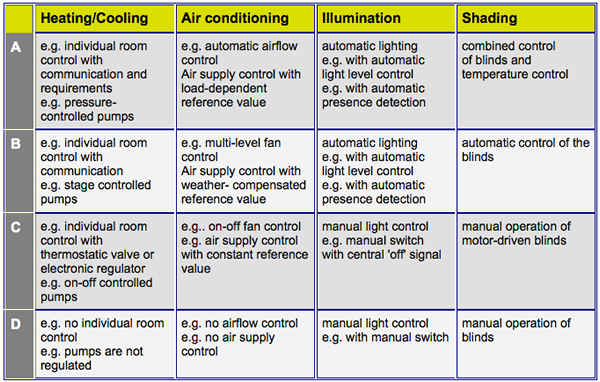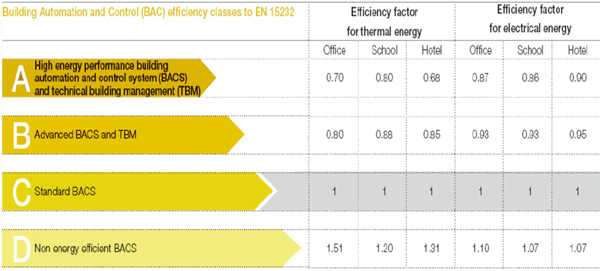 By Simon Buddle, KNXtoday.
By Simon Buddle, KNXtoday.
Grade C or above? I’m sure I’ve heard that somewhere before. Of course! It was the constant mantra that teachers used in school when describing our exam requirements. I was simply pleased to get through in one piece, and I’m pretty sure my teachers were pleased to see the back of me! But it seems that there is no escape – the mantra is back, only this time it applies to the energy efficiency of our building automation installations.
In Europe, in terms of performance in Building Automation and Control (BAC) under the standard EN 15232:2012, buildings energy efficiency classes are graded A, B, C and D, with A being the best.

Under the EN15232 standard, ‘C’ is definitely a pass, or perhaps we ought to say, the minimum standard that we should aim to achieve. Any KNX system containing both heating and lighting elements should be capable of hitting this C standard for BACS (Building Automation and Control System) without even breaking sweat. This standard, as we know, is not yet mandatory in the residential arena, but it is in commercial buildings. In any case, whether you work in residential or commercial, it must make sound economic sense to the end user to use EN15232 as a reference point for our installations.
What should we do about it?
There are many ideas that come out of the standard of which we should take note. For instance, with lighting control, the benefits of central switching or control will ensure that the home is off when no one is at home, and presence detection can be used to switch on and, most importantly, off lights when rooms are empty. Those simple criteria fulfil the requirements of the energy efficiency classes C, B and A.

Most clients would appreciate knowing that they are being energy efficient and how much money this is saving them. In larger spaces, there is also value in actively monitoring the sunlight or lux level coming into the building, as this enables you to dim the lighting levels whilst maintaining a consistent amount of light in the space.
There is certainly value in creating some data to support the cost saving case. It is simple enough to create a spreadsheet of installed luminaires, wattage, energy cost and ‘on’ time. From this it becomes easy to demonstrate how much money could be saved by controlling the lights.
Heating and Cooling
Communicating valves, two-stage heating pumps and weather compensation with interlocked heating and cooling are commonplace within the KNX world. We are all familiar with the hotel room key card principle – a simple shut off device for the room when it is not occupied – well some valves come with the facility to add presence directly on the device. Even without this ability, it would be easy to mange room heating locally with a presence detector.
Why heat an empty room? Surely it is better to use a setback temperature. This is actually common practice in hotels where, even when the room is occupied, the night time set point is reduced by 2°C. This represents a significant cost saving, and in general is rarely noticed by the sleeping patrons.
Automated Blinds
Shading, whilst becoming increasingly important here, is without doubt the new kid on the block. With glass becoming prominent as a viable building material both aesthetically and financially, the simple addition of blinds is becoming increasingly relevant.
Too much light in a space can certainly create difficult working conditions for those of us who are chained to a computer screen, but the extra heat generated through the summer can make it a thoroughly unpleasant day at the office. New glass technology undoubtedly helps, but blinds are critical to the success of any new build office space. Control of blinds via lux sensors does require careful consideration. Where do you measure the light level? How many blinds do you control? How quickly should the blinds activate? These are all important questions that require thought and an understanding of how a space will be used.
Cost Savings
Creating an integrated system is ‘what we do.’ it is easy to forget the value of this in energy terms. The growing gulf between oil discoveries and oil consumption highlights the need for all of us to be more energy-efficient in the coming years.

When assessing the impact of BAC and TBM (Technical Building Management), the ‘A’ energy efficiency class is considered (for the purposes of non-expert calculations) to provide an 80% consumption saving, and even a ‘B’ rating provides a saving of some 50%. Like so many energy-saving, eco or sustainable homes technology, it is not about simply providing one huge change in the building, it is about the cumulative effect of many small improvements that ultimately create a significant benefit.
Conclusion
The knowledge we have and the resources we are able to tap into make the KNX market a perfect arena in which to successfully implement energy-saving technologies. In my opinion, EN15232 is another welcome addition to an ever-increasing armoury of reasons to use KNX as the platform for both residential and commercial building management systems. A discussion with clients about its aims and benefits will, I’m sure, benefit us all.
Simon Buddle is a systems integration consultant and installer. Simon is also a regular contributor to KNXtoday magazine and HiddenWires magazine, and the first winner of the CEDIA Region 1 Special Recognition Award.
You are welcome to comment on this article. See below.











